Bridge Route
From bank to bank
If there is something truly typical for Prague, it is its bridges. The Vltava River, with its ideal width, has allowed for the construction of numerous structurally and aesthetically unique bridge structures. A walk will introduce you to their aesthetics and functionality. Did you know, for example, that all the bridges in the city center, except for the railway bridge under Vyšehrad, are arched? The bridge route will provide you with context, and perhaps thanks to it, you will finally remember which bridge leads to the National Theatre and which one leads to the Dancing House.

Duration:
1 hodina
Number of stops:
6 + 9
Lenght:
4,9 km
MHD start:
Palackého most
MHD end:
Čechův most
Palacký Bridge
Architect: Bedřich Münzberger, Josef Reiter
Year of completion: 1878
The first of the modern arch bridges was named after František Palacký, the founder of modern historiography and the “father of the nation”. His patriotism is expressed in the bridge’s design through the use of materials in the colors of the national flag – blue granite, red and yellow sandstone, and white marble. The tops of the bridge arches are adorned with symbols of Czech cities located on the Vltava and Labe rivers. The bridge was created as a new connection between the banks of the Vltava River and served not only for transportation but also for supplying Nové Město with coal from Smíchov Station. During World War II, Prague residents had to get used to the name “W. A. Mozart Bridge”. From 1897, sculptures depicting mythical figures from Czech history by Josef Václav Myslbek were placed on both bridgeheads, but they were damaged during the Allied bombings in February 1945. Copies of these sculptures, along with the original Smíchov sculptures, can now be found in the gardens at Vyšehrad.

Jirásek Bridge
Architect: Vlastislav Hofman, František Mencl
Year of completion: 1933
Jirásek Bridge marks the culmination of the era of pre-war bridges and is also the last work of the builder František Mencl, who was involved in the construction of four other bridges in Prague. Jiráskův Bridge, whose architectural design was determined by Vlastislav Hofman, was gradually put into operation and reached its full use in 1933. The purpose of building this river crossing was to extend Resslova Street and connect it with the waterfront. On this reinforced concrete bridge, the lighting masts and the concrete railing made of prefabricated parts carrying elements of functionalism are worth noting. It is the railing that casts beautiful shadows on the sidewalk on sunny days. During World War II, the bridge was renamed Dientzenhofer Bridge. The new name was intended to commemorate a supposedly Baroque pavilion built according to the design of Kilián Ignác Dientzenhofer, which was removed on the Smíchov side of the bridge. After the war, the bridge was once again named after the famous Czech writer.

Legion Bridge
Architect: Antonín Balšánek, Jiří Soukup
Year of completion: 1901
One of the few originally preserved bridges in Prague now commemorates the brave deeds of Czechoslovak legionaries, but it was previously named after the Austrian Emperor Franz I. The same name belonged to an elegant chain bridge that stood in the same location between 1841 and 1898. The chain bridge was insufficient in capacity and dangerously swayed under heavier loads. Therefore, a new bridge was constructed. It was built in the eclectic style, which is characterized by the imitation of various architectural styles. The bridge is adorned with a pair of tollbooths on both sides, decorated with mascarons, city coats of arms, and domed roofs. In the middle of the bridge, there is a staircase with decorative vases, which provides access to Střelecký Island.

Charles Bridge
Architect: mistr Otto, Petr Parléř
Year of completion: 1402
The famous Charles Bridge stands at the site of at least two previous bridges – a wooden one, over which the body of St. Wenceslas was brought to Prague, and the more well-known Judith Bridge, destroyed by a flood in 1342. For a long period of 450 years, the Charles Bridge was the only bridge across the Vltava River. The importance of this structure is confirmed by a pair of richly decorated bridge towers and baroque sculptures gradually installed at the turn of the 17th and 18th centuries. The name of Emperor Charles IV has been associated with the bridge since 1870 when four additional bridges were already standing in Prague. Before that, it was known simply as the Prague Bridge or the Stone Bridge, and as the only bridge, it had to serve all the important functions for the city’s operation. A horse-drawn tram was introduced on the bridge, and from 1905, an electrified tram was also established, powered by a clever system designed by František Křižík. The bridge served automobile traffic until 1965.
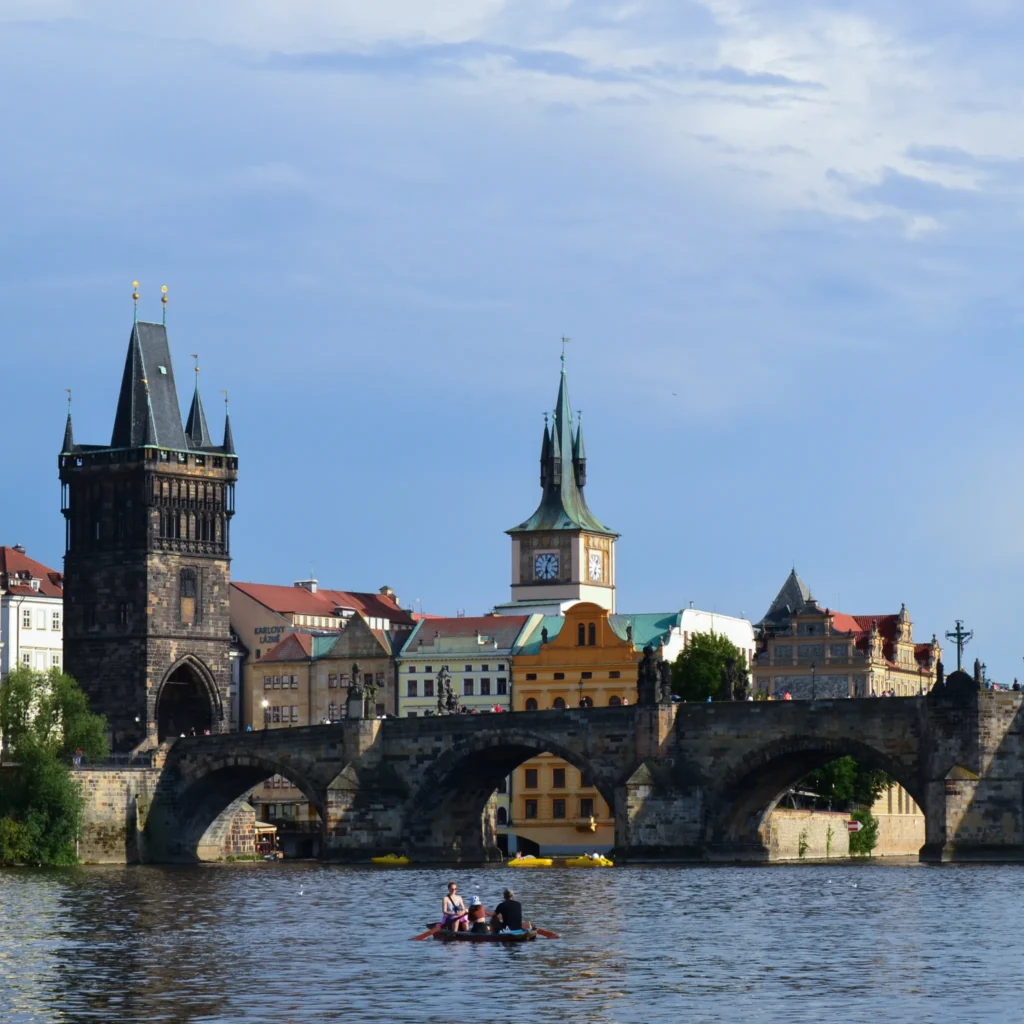
Mánes Bridge
Architect: Mečislav Petrů, František Mencl
Year of completion: 1914
The Mánes Bridge, initially named the Archduke Franz Ferdinand Bridge for the first six years, is a modernist structure with slight hints of Cubism. The remaining fountain sculptures by sculptor Emanuel Halman and the lost toll collector’s booth showcase elements of Cubism. The bridge replaced the original suspension Rudolf’s Bridge, which is now commemorated on the Lesser Town riverbank by a timber-framed cottage that once served as a toll booth. The Manes Bridge is named after the romantic painter Josef Mánes, whose statue by Bohuslav Kafka can be found on the right bank. The bridge pillars are made of granite, and the four arches are constructed of plain concrete. Notably, there are valuable reliefs by František Bílek, Jan Štursa, and Josef Mařatka. These artistic works on the pillars depict scenes from the lives of Vltava rivermen, among other subjects.

Čech Bridge
Architect: Jan Koula, Jiří Soukup, František Mencl
Year of completion: 1908
The shortest bridge in Prague, yet also the largest Art Nouveau structure in the Czech Republic. The Čechův Bridge, spanning 169 meters, connects Pařížská Street with the Edvard Beneš Embankment. During its construction, there were plans to connect it to the planned Letná Relief Tunnel. However, this grand vision did not materialize, and today the bridge leads only to the staircase of the former Stalin Monument. The bridge is truly unique, not only due to its Art Nouveau details but also because of its split pillars and steel arches. It features magnificent toll collector’s booths in the form of majestic columns with statues of geniuses by Antonín Popp. The pillars themselves are adorned with a pair of bronze statues of female torchbearers on one side and a quartet of hydras on the other. In the original plans, the torchbearers would have emitted real flames, and water would have flowed from the hydras. This concept may become a reality in the future.

Zastávky mimo trasu

Railway Bridge
Architect: První Českomoravská továrna na stroje, bratři Prášilové, Ruston a spol.
Year of completion: 1901
Similar to other railway bridges, the one beneath Vyšehrad does not have an official name, despite being a vital link between Smíchovské and Hlavní nádraží (the main railway stations). Since 1871, an old single-track bridge serving only freight transportation has stood in the same location. At the beginning of the 20th century, it was replaced by the current double-track bridge, featuring pedestrian walkways and three iconic arches. The shape of these arches complements the nearby Vyšehrad and blends into the scenery of Prague’s bridges. Although the bridge is a well-known landmark in Prague, its maintenance has been underestimated in the past, and apart from the recently restored pedestrian walkways, the bridge is in poor technical condition. This, combined with the bridge’s insufficient capacity, led the Railway Administration to launch an architectural competition that resulted in a proposal that does not involve renovating the bridge but rather demolishing it. The future of this structure is therefore highly uncertain.

Hlávka Bridge
Architect: Pavel Janák, František Mencl
Year of completion: 1912
The Hlávka Bridge is the only bridge in Prague that has retained its name throughout its existence. Its unique feature is its layered construction, providing valuable evidence of the development of architecture at the time. The original southern part, leading from Nové Město to Štvanice, showcased grand architecture and was made of steel. The following year, the innovative northern part leading to Holešovice was constructed using concrete, demonstrating the capabilities of this groundbreaking material. In the 1970s, the bridge was rebuilt to accommodate the emerging expressway. The steel section was demolished and replaced, while the concrete section, designed by architect Pavel Janák, was expanded. In 1983, a forebridge with an intersection was added near the Vltavská metro station, adorned with the sculpture group “Work and Humanity” by sculptor Jan Štursa. The island pillars of the bridge on Štvanice are adorned with reliefs of nudes by Ladislav Kofránek and Bohumil Kafka.

Libeň Bridge
Architect: Pavel Janák
Year of completion: 1928
Reportedly the only cubist bridge in the world, it has been connecting Holešovice and Libeň since the 1920s. It is also the only bridge in Prague that was built “on dry land,” so to speak. At the time of its construction, the regulation of the Vltava River was also taking place, allowing the bridge to be built over a section of the newly excavated riverbed that had not yet been flooded. Additionally, the bridge spans the newly created Rohanský Island, where a transfer station was initially planned according to Pavel Janák, the bridge’s architect. Janák himself designed a series of buildings following its line, but these visions from the First Republic era were never realized. The style of the bridge represents a wave of avant-garde functionalism and cubism, which can be observed in the shaping of the bridge pillars, lamps, and other details. Despite being a significant work, it had never been repaired during its existence and faced the risk of demolition. However, in September 2022, extensive reconstruction work officially began.

Troja Bridge
Architect: Roman Koucký, Ladislav Šašek, Libor Kábrt a Jiří Petrák
Year of completion: 2014
One of the architects involved in the construction of the Troja Bridge is Roman Koucký, who is also known for designing the Dlouhý Bridge in České Budějovice and the iconic Mariánský Bridge in Ústí nad Labem. The current bridge, connecting Holešovice with Troja, was built as a replacement for the so-called Rámusák, which was constructed as a temporary structure during the building of the Barikádníků Bridge in the 1980s. It served as a bypass for tram traffic across the river until 2013 when construction of the new elegant structure was underway nearby. The new Troja Bridge has received several awards in the Czech Republic and abroad. It features two traffic lanes for automobiles in each direction, tram tracks, and a sidewalk for pedestrians and cyclists. It has become a popular subject for photographers and filmmakers.

Braník Bridge
Architect: Jiří Klimeš a kolektiv ČVUT
Year of completion: 1955
The Braník Bridge is popularly nicknamed the “Bridge of Intelligence” because it was built by members of the so-called “class enemies” of communism. These educated individuals, such as lawyers, doctors, and others, were forced by the regime to work in manual labor and similar professions. The bridge has been standing there since the 1950s, but railway operations did not commence until 1964 when the connecting railway track was completed. The project was initially planned for double-track operation, but you won’t find a second track on the bridge. Although it was briefly laid on the bridge, it had to be removed after unsuccessful load tests. Similarly, the Chuchle Railway Tunnel that follows the bridge is not adapted for double-track operation either.

Štefánik Bridge
Architect: Vlastislav Hofman, Oldřich Širc
Year of completion: 1951
A reinforced concrete functionalist structure has been spanning the Vltava River for over 70 years. It stands in the place of its iron predecessor – the František Josef I Bridge, which was colloquially referred to as Eliska‘s, named after the monarch’s wife. Its capacity gradually became insufficient, and it was therefore replaced by the current bridge. At the time of its construction, it was named Šverm Bridge after a member of the Communist Party of Czechoslovakia, whose statue was located near the bridge on the right bank of the Vltava. However, both the statue and its name have been taken by time, and since the 1990s, the bridge has been named after a Czechoslovak Minister of Defense.

Negrelli Viaduct
Architect: Alois Negrelli, firmy bratří Kleinů a Vojtěcha Lanny
Year of completion: 1851
Until 1910, it was the longest bridge in Europe, thanks to its 87 arches spanning across Nové Město, Karlín, Holešovice, the Vltava River, and Štvanice Island. The Negrelli Viaduct, dating back to the mid-19th century, is the second oldest surviving bridge in Prague. Its construction allowed trains to depart from Masarykovo nádraží towards Dresden. The section above Karlín is made of sandstone, while granite was used as the construction material for the parts over the river. The bridge’s simplistic design adds to its aesthetic appeal, as does its uniform concept, which was later altered by subsequent reconstructions and additions. From 2010 to 2012, the entire 1,111 meters long structure underwent renovation, restoring its original charm.

Štvanice footbridge
Architect: Petr Tej, Marek Blank, Jan Mourek
Year of completion: 2023
The latest entry to the scenery of Prague’s bridges is the footbridge with the illustrative nickname HolKa, which connects the riverbanks of Holešovice and Karlín. Upon first sight of the thin, subtle line hovering above the river, one might think that the bridge probably defies the laws of physics. This is thanks to the clever decision of the authors to use ultra-high-performance concrete, which allowed them to reduce the overall height of the structure to just 1.85 metres and ensured that the 57 connected profiles together are supported by only 5 columns with a span of up to 60 metres.
A beautiful wrought iron handrail by artist Aleš Hvízdal complements the entire length of the bridge and the contrast between the concrete body and the perhaps archaic handrail allows the minimalist appearance of the footbridge to stand out. Especially the youngest admirers will be attracted by the finishing of the handrail with animal motifs. The entrance to the footbridge in Holešovice is guarded by a pair of bulls, which recalls the history of Prague’s abattoirs. The entrance from Karlín is protected by a pair of horses, referring to the wartime history of the Prague Invalidovna, and at the ramp to the Štvanice island we can find two rabbits and a sculpture called River by Jan Hendrych.

Garden route

Feminist route
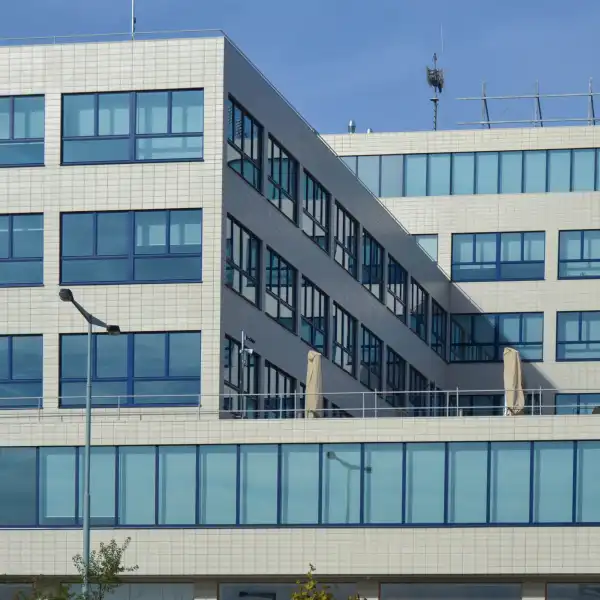
Functionalist Route

Passage Route
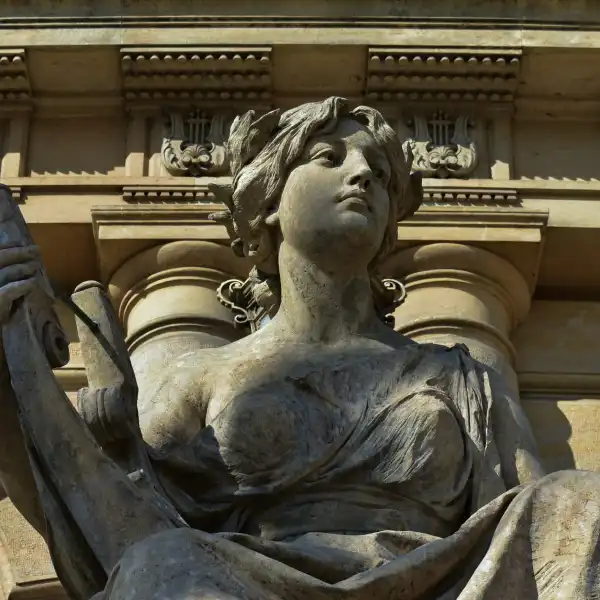
Music Route

Church Route (1930s)

Prager’s Route
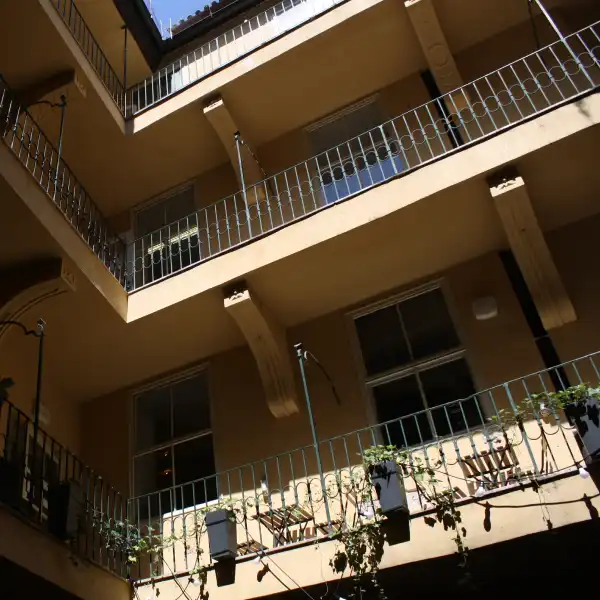
Inner Courtyard Route

Glass Route

Empty Route

Literary Route

Brutalist route
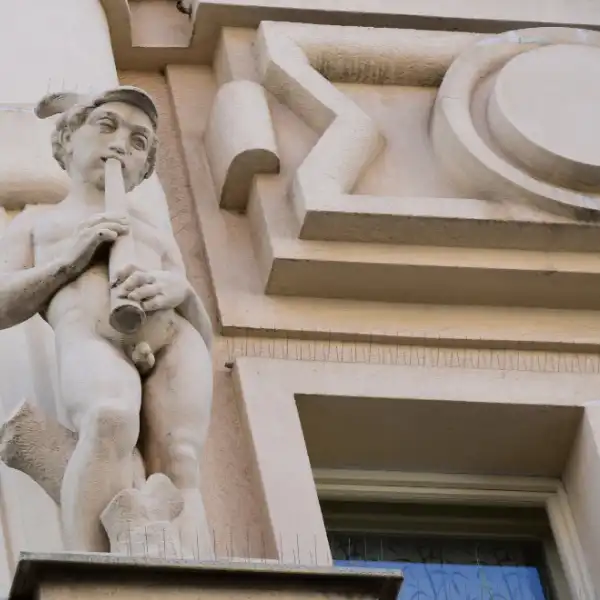
Rondocubist route
